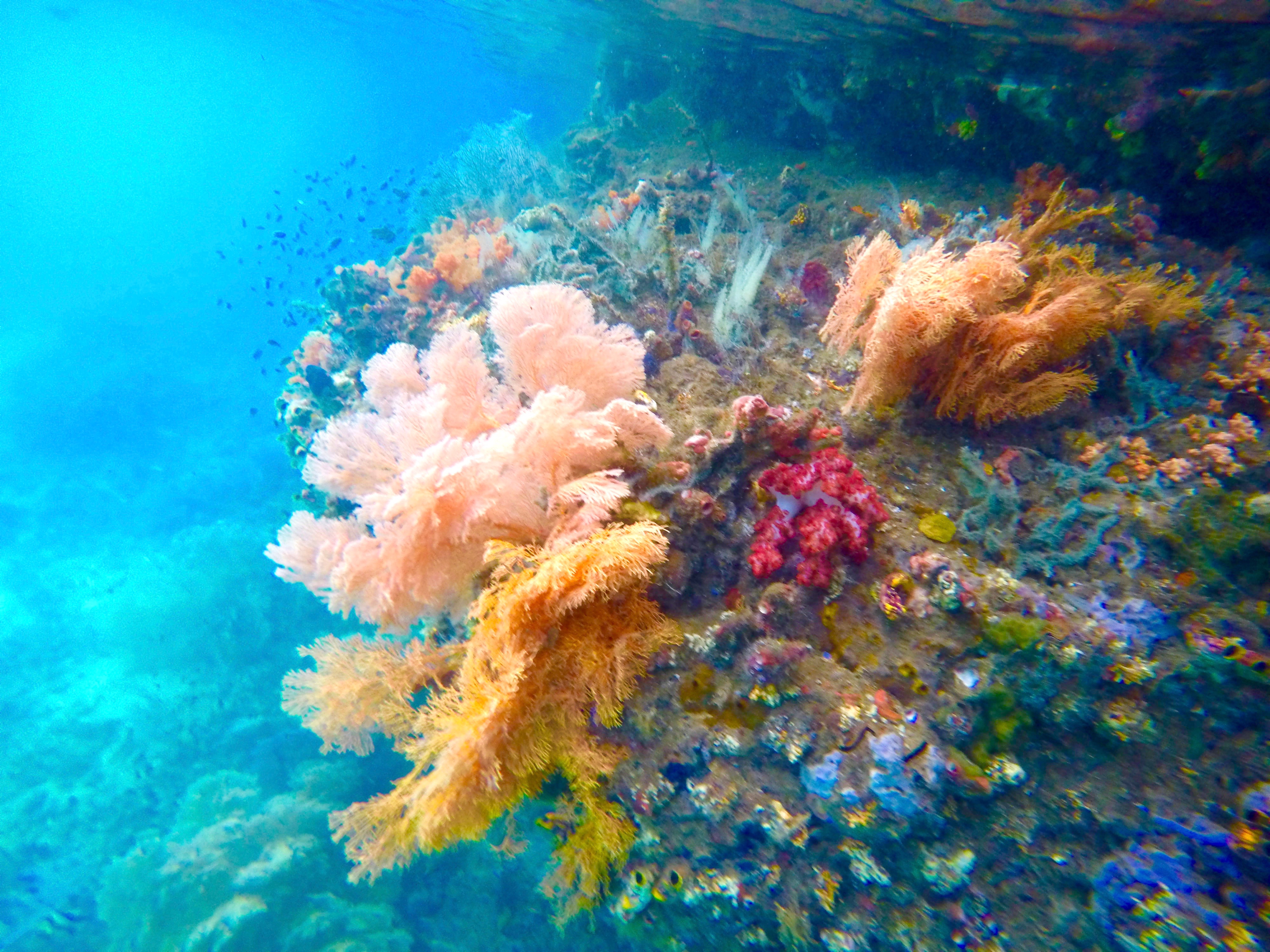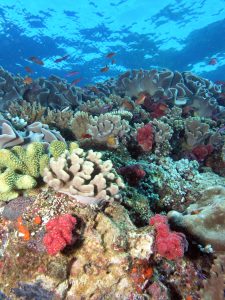
Coral: a mineral, plant, and animal all in one (oh my!) This complex being serves many purposes- and although it comprises just 1% of the ocean floor, coral sustains a whopping 25% of all marine life. Animals use coral as a home, as protection, as nurseries, even as food (check out this cool piece about parrotfish diet and their poop!).
But it’s not just marine animals that depend on coral. Humans have developed a potential need for coral as well! In addition to sustaining the fish that many of us need for our commercial fisheries, ecotourism industries, and other facets of local cultures, coral reefs now serve as a modern medicine cabinet of the 21st century. Unlike our adaptive immune system which builds memory based on previous exposure to bacteria or viruses, coral’s innate immune system does not build any memory and already has specific responses to foreign stimuli. Consequently, coral develops very unique, organic defensive mechanisms which scientists are able to extract for potential treatments and cures for ailments like asthma, arthritis, and even osteoporosis or cancer (for a comprehensive review, see Cooper et al.’s (2014) piece)
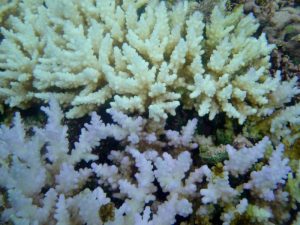
Unfortunately, coral is in danger- and the many reefs which support a wide variety of organisms (including humans) are rapidly dying. The massive influx of carbon dioxide characteristic of climate change throws our oceans off balance, causing it to become increasingly warm and acidic. In combination with other sorts of anthropogenic activities (human activities that cause pollution), coral reefs are deteriorating at an increasingly rapid and concerning rate. Coral has a special relationship with symbiodinium, otherwise known as the algae zooxanthellae, which provide the coral food in return for easy access to shelter and sunlight. When the ocean’s temperature rapidly fluctuates or the water is too polluted, coral spits out this zooxanthellae and bleaches in the process. Coral can actually recover from bleaching, but conditions are worsening instead of recovering so bleached coral eventually dies (a state which coral cannot recover from). To top it all off, ocean acidification corrodes the calcium-carbonate skeleton in coral, increasing their mortality rates by making them weaker and less resilient
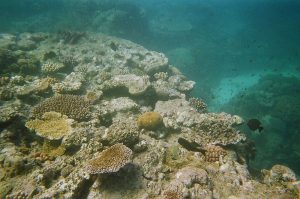
In the last 30 years, numerous mass coral bleachings absolutely decimated reefs, killing over half the world’s coral. Coral reef based environments like the The Great Barrier Reef (which lost 50-80% of its coral after a 2016 mass-bleaching) and the Caribbean (which similarly lost 80% of its coral over these past three decades) are showing us that natural adaptation and resilience is just not enough to protect coral against the impacts of a rapidly changing environment.
There are many theories about how we can help heal coral reefs from the impact of our activities and fossil fuel usage, namely through active reef restoration. Chan et al. (2018) posit that one way to bolster coral is through interspecific coral hybridization: cross-breeding different species of coral within the same genus to produce a hybrid offspring. Research has previously documented natural coral hybridization allowing species to diversify and self-preserve, especially in the genus Acropora (branching coral). Hybridization is key to diversification and self-preservation as cross-breeding can increase genetic variation of coral as well as conserve genetic diversity from parent species at risk of extinction.
Chan et al. (2018) choose 4 types of Acropora species to cross breed. They hybridize purple tipped acropora with bush acropora, Acropora tenuis x Acropora loripes, and Acropora sarmentosa with flat branched acropora, Acropora sarmentosa x Acropora florida. While some hybrids faced lower fertilization rates, overall each hybrid demonstrated limited prezygotic barriers: anything that can prevent mating and fertilization. Additionally, all hybrids showed greater climate resilience than at least one of their purebred siblings when exposed to elevated levels of carbon dioxide. Not only did these hybrids have better survival rates in “normal”, baseline conditions after 1 year, they also had noticeably better survival rates in these elevated carbon dioxide conditions. Another important part of coral survival is how well the symbiotic algae, zooxanthellae, are able to photosynthesize and feed the coral. Hybrids of the purple tipped acropora and bush acropora showed no reduced photochemical efficiency, the ability for these algae to photosynthesize food, in elevated carbon dioxide conditions while their purebred siblings did. Finally, Chan et al. (2018) note that one of the hybrids of A. sarmentosa and the flat branched acropora even grew larger in size compared to its only surviving purebred sibling at 1 year in the baseline condition.
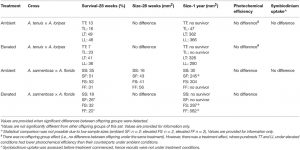
Interspecific coral hybridization is a relatively new concept, and Chan et al.’s (2018) study supports the idea that hybridizing can help bolster coral and aid in reef restoration. Demonstrated by the hybrids produced by the four species of Acropora, hybridization can increase genetic variation and consequently also increase climate resiliency. At least one (if not both) hybrids in either cross-bred pair generally showed higher fitness and resiliency than their siblings. Additionally, none of the hybrid offspring performed worse than the purebred offspring, which also suggests that there were no negative effects from cross breeding these species of coral. There are a few next steps to fully understand whether hybridization could be part of the solution to our coral dilemma. Chan et al.’s (2018) study only observed coral up to a year of age, and further studies need to be multigenerational and last much longer (perhaps around 3-7 years instead). Additionally, further research must implement fieldwork in addition to lab work. How do hybridized coral survive in the wild? Are there any extraneous factors or unknown pressures that might alter their resiliency? How do offspring of cross-bred species fare?
While there are many ways we can individually help coral, i.e. cutting down on our own fossil fuel usage to reduce the impact of climate change, active reef restoration is another initiative we must pursue and support. Chan et al. (2018) are part of the first steps in hybridizing coral to create a stock with higher climate resilience, which is essential in ensuring that we restore, preserve, and maintain coral reefs for generations to come.
Rishya is a multimedia science communicator with an MS in Media Advocacy from Northeastern University, specializing in Environmental Science Communications and Policy. She spent a year in informal education and policy advocacy at the New England Aquarium as an Educator and at Save the Harbor/Save the Bay as their Communications and Public Relations Coordinator. She also interned for PBS science series, NOVA and was awarded a 2019 Rapport Public Policy Fellowship, which she served at the Massachusetts Division of Marine Fisheries. Rishya’s areas of focus are environmental science, marine science, climate change…and video games!

